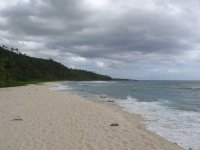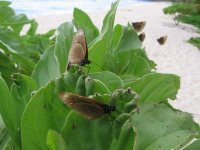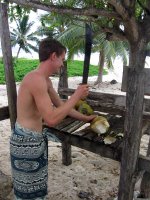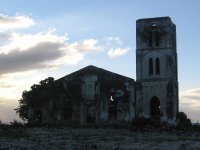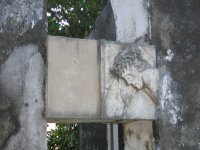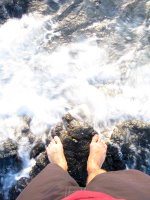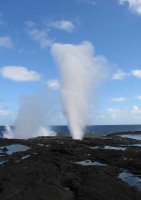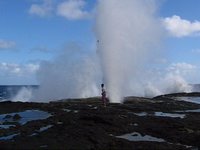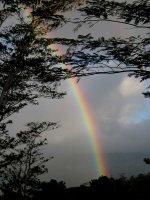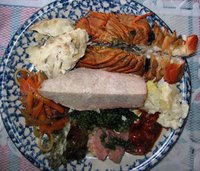
After saying goodbye to Maka we drove from Papa to Manase. Along the way we passed through some beautiful parts of the island (including the quite picturesque Asau harbour). Manase is the most popular destination for tourists to Savaii and there are several places to stay. Tanu's would probably attract the majority of custom given its cheap nightly rate of $50 Tala but Jane's, Vacations and Stephenson's all have many guests. Tanu's was booked out for Sunday night so we chose to stay at Vacations. At $75 we could afford it and their fales looked like they were in good shape. We didn't regret our decision.
We timed our arrival perfectly, climbing out of the car to see the Sunday to'onai lunch waiting for us. It was a feast. Bugs, palusami, pig and taro, oka. Fresh salty seaweed, baked fish, potato salad and stir fried vegetables. We ate our fill then proceeded to our fales where all four of us crashed out for an afternoon nap. Eating's hard work you know.
The rest of our time at Vacations was spent in very similar fashion. We either slept or floated in the ocean. We'd covered a fair bit of ground by this stage so it was good to take some time out and enjoy doing nothing.

Not long after breakfast we packed up and headed back towards Asau harbour, turning inland at the village of Safune. Our destination was Mt. Matavanu. Mt. Matavanu erupted between 1905 and 1911, its lava flows spilling north and north-east towards the villages of Asau and Saleua especially. The lava fields I visited earlier in the year are the result.
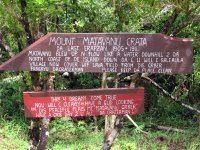
Thanks to the efforts of "Da Craterman" getting to the top of the mountain is much easier than it used to be. We were able to drive most of the way, stopping once we reached the Craterman's small hut. From there we walked with the Craterman as our guide.

He's an intriguing character, the Craterman. He spends his days in his hut up the mountain waiting for visitors but he doesn't pass his time idly. He maintains the tracks leading up and around the mountain and spends a lot of time fashioning signs to place along the way. For a fee, interested visitors can have their very own sign made. Creating these signs takes a little time, so the Craterman sends a photo of the sign and a letter to the people who have paid for it once it's completed.
The Craterman also keeps statistics about the number of signs he's created (541 as of this writing) and the number of visitors from different countries he's received. By his latest count he's had people from 85 different countries come to Mt. Matavanu.

We walked with the Craterman up to the first of two craters. The view was amazing. Standing at its lip, we were able to look down into dense foliage. Countless trees, shrubs, vines, moulds and fungii populate the crater and we had the perfect view to appreciate them. Looking north towards the coast we could see Asau harbour and Manase.
As the rain started to fall we made our way back to the Craterman's hut and our car. We said our farewells and drove back down to the main road. We stopped in at a neighbouring village for a swim in freshwater pools and chatted with a Peace Corps volunteer stationed there. Afterwards we headed back through Manase and drove along the east coast on the way to the wharf at Salelologa. After two and a half days our road trip was coming to an end. Or so we thought.
We reached Salelologa and joined the queue of vehicles for the 4pm ferry. We discovered that the ferry was already booked to capacity and we were placed on stand-by. We waited and waited and eventually realised that we were not going to get the car onboard. The next service with barely any spare car space would be the 10am ferry the next day.

We said goodbye to Alexa who absolutely had to return to Apia that day and drove back to Clair's place in Palauli. There we caught up with Maka and another Peace Corps volunteer Laura. We decided to take advantage of the hire car and picked up a couple more Peace Corps before driving around to the east coast of the island for dinner at the Italian restaurant there. We had a great meal and a lot of fun. Once again the language competency of the Peace Corps shone through as they casually joked with our waiter and proprietor of the restaurant.
At the conclusion of the evening we drove the Peace Corps back to their village not far from Clair's (Satupaitea I think) and returned to Clair's to crash out for the night. The next morning we returned to the wharf and managed to get ourselves aboard the 10am ferry. Our trip from the wharf was a little interesting, as our car developed engine problems but we made it home in one piece.
All in all, it was an excellent weekend. We saw some amazing things, hung out with great people and had a lot of fun. Savaii is a wonderful place and is well worth visiting.
 I asked the taxi driver (pictured here) to stop the car and I hopped out to have a chat with the man. I enquired as to why he was casually walking around in my clothes. Thanks to my poor command of Samoan and his equally poor command of English, we didn't make much progress. At just the right moment, my taxi driver stepped out of the car and proceeded to give the security guard what seemed like a fair bollocking. A hasty conversation ensued and finally, with smiles all around, claps on the back and handshakes, we parted ways.
I asked the taxi driver (pictured here) to stop the car and I hopped out to have a chat with the man. I enquired as to why he was casually walking around in my clothes. Thanks to my poor command of Samoan and his equally poor command of English, we didn't make much progress. At just the right moment, my taxi driver stepped out of the car and proceeded to give the security guard what seemed like a fair bollocking. A hasty conversation ensued and finally, with smiles all around, claps on the back and handshakes, we parted ways.






